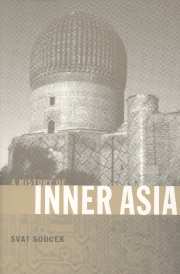Book contents
- Frontmatter
- Contents
- List of maps
- Preface
- Introduction
- 1 The beginnings
- 2 The Kök Turks, the Chinese expansion, and the Arab conquest
- 3 The Samanids
- 4 The Uighur kingdom of Qocho
- 5 The Qarakhanids
- 6 Seljukids and Ghaznavids
- 7 The conquering Mongols
- 8 The Chaghatayids
- 9 Timur and the Timurids
- 10 The last Timurids and the first Uzbeks
- 11 The Shaybanids
- 12 The rise of Russia, the fall of the Golden Horde, and the resilient Chaghatayids
- 13 The Buddhist Mongols
- 14 Bukhara, Khiva, and Khoqand in the seventeenth to nineteenth centuries
- 15 The Russian conquest and rule of Central Asia
- 16 From Governorates-General to Union Republics
- 17 Soviet Central Asia
- 18 Central Asia becomes independent
- 19 Sinkiang as part of China
- 20 Independent Central Asian Republics
- 21 The Republic of Mongolia
- Summary and conclusion
- Appendix 1 Dynastic tables
- Appendix 2 Country data
- Select bibliography
- Index
9 - Timur and the Timurids
Published online by Cambridge University Press: 05 June 2012
- Frontmatter
- Contents
- List of maps
- Preface
- Introduction
- 1 The beginnings
- 2 The Kök Turks, the Chinese expansion, and the Arab conquest
- 3 The Samanids
- 4 The Uighur kingdom of Qocho
- 5 The Qarakhanids
- 6 Seljukids and Ghaznavids
- 7 The conquering Mongols
- 8 The Chaghatayids
- 9 Timur and the Timurids
- 10 The last Timurids and the first Uzbeks
- 11 The Shaybanids
- 12 The rise of Russia, the fall of the Golden Horde, and the resilient Chaghatayids
- 13 The Buddhist Mongols
- 14 Bukhara, Khiva, and Khoqand in the seventeenth to nineteenth centuries
- 15 The Russian conquest and rule of Central Asia
- 16 From Governorates-General to Union Republics
- 17 Soviet Central Asia
- 18 Central Asia becomes independent
- 19 Sinkiang as part of China
- 20 Independent Central Asian Republics
- 21 The Republic of Mongolia
- Summary and conclusion
- Appendix 1 Dynastic tables
- Appendix 2 Country data
- Select bibliography
- Index
Summary
If the Mongol interlude (1220–1370) was a traumatic experience in the history of Central Asia, the Timurid period (1370–1507) can be a viewed as ultimately its most glorious one. It is true that the founder of this dynasty, Timur (ruled 1370–1405), was a ruthless conqueror not unlike Genghis Khan, and spent much of his life engaged in military campaigns that wrought similar massacres and destruction. These, however, befell other areas (Iran, the Golden Horde), while sparing Central Asia itself. At any rate, Timur's successors showed less aptitude for large-scale conquest than for enjoying the good life at home; and despite frequent infighting for the possession of this or that portion of the inheritance, many of them also encouraged culture and the arts. Timur himself had endeavored to embellish his capital, Samarkand, with grandiose architectural monuments some of which still constitute the pride of modern Uzbekistan: his own mausoleum, the Gur-i Emir (“The Sovereign's Tomb”), is the most famous example. Timur's quaint European appellation, Tamerlane, is a deformation of Timur-i lang, “The lame Timur,” a Turco-Persian name as it appears in certain Persian sources because of a leg maimed by a wound he sustained early in his life.
Timur was born around 1336 in Transoxania near Kesh – later known as Shahrisabz – in the Kashka Darya region of what is today the Republic of Uzbekistan. He was a Turk of the Barlas tribe; this tribe, like many others, boasted a Mongol name and ancestry, but for all practical purposes it was Turkic.
- Type
- Chapter
- Information
- A History of Inner Asia , pp. 123 - 143Publisher: Cambridge University PressPrint publication year: 2000



